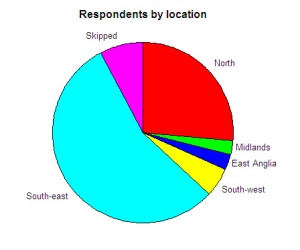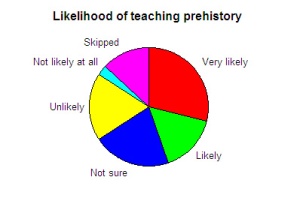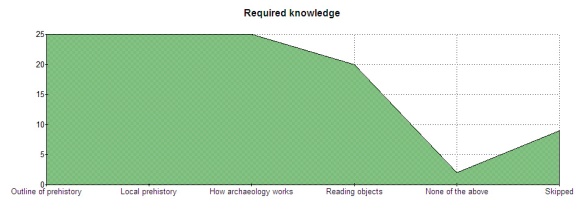A few weeks ago we started an online survey to capture some thoughts from teachers in England on how they are feeling about teaching prehistory in 2014. We know there’s a lot on teacher’s minds at the moment about the new curriculum so we were very pleased to receive 38 responses. Here’s a breakdown of the answers. (Apologies for the garish colours in the early charts, I worked out how to change it later! Kim).
About the respondents
 The survey was in three parts. The first part asked the respondents a litle about themselves, though it was completely anonymous. This was the breakdown by location. It’s not an even spread, by any means, with over half the respondents from the south-east and only just over a quarter from the north, with a few from other regions.
The survey was in three parts. The first part asked the respondents a litle about themselves, though it was completely anonymous. This was the breakdown by location. It’s not an even spread, by any means, with over half the respondents from the south-east and only just over a quarter from the north, with a few from other regions.
 The second question asked respondents how long they had been teaching. This was a more even split between quite new teachers and more experienced ones.
The second question asked respondents how long they had been teaching. This was a more even split between quite new teachers and more experienced ones.
The last bit of information we were interested in looking at was teacher’s main qualifications before going into teaching. There is anecdotal evidence that archaeologists have not been accepted onto teacher training courses as it’s not on the curriculum, but we were pleased that four of our respondents had studied it. This may be a biased sample, though, given the subject matter of the survey.
 Also, given the subject matter of the survey, it attracted a lot of history graduates, but there is a fairly mixed qualifications background in the respondents, including one anthropologist. Respondents were able to choose more than one subject area and also write in other subjects that weren’t on the list.
Also, given the subject matter of the survey, it attracted a lot of history graduates, but there is a fairly mixed qualifications background in the respondents, including one anthropologist. Respondents were able to choose more than one subject area and also write in other subjects that weren’t on the list.
Will teachers be teaching prehistory?
 We wanted to know how likely it was that our respondents would be teaching prehistory in 2014. It is early in the preparations for the new curriculum and so many respondents weren’t sure. It could be that the respondents themselves wouldn’t be personally teaching prehistory in 2014 but that someone else in their school would be. This question could have been worded better to get that information. Nearly half of respondents were likely or very likely to teach prehistory.
We wanted to know how likely it was that our respondents would be teaching prehistory in 2014. It is early in the preparations for the new curriculum and so many respondents weren’t sure. It could be that the respondents themselves wouldn’t be personally teaching prehistory in 2014 but that someone else in their school would be. This question could have been worded better to get that information. Nearly half of respondents were likely or very likely to teach prehistory.
We also asked which year group it would be taught to. This gave a fairly even spread of ages, despite it being recommended for early Key Stage 2 in the curriculum framework.
 Year 3 and 4 were the most likely to be taught prehistory, but for five respondents there was an expected whole school approach to the topic as well. If taught in Year 2, perhaps the approach would be through a local history study, though we didn’t ask that question in this survey.
Year 3 and 4 were the most likely to be taught prehistory, but for five respondents there was an expected whole school approach to the topic as well. If taught in Year 2, perhaps the approach would be through a local history study, though we didn’t ask that question in this survey.
Support for teachers
The final section of the survey was concerned with what kind of support teachers feel they need. The first question was merely about whether they felt ready to teach prehistory, to which seven responded ‘Yes’ and 22 responded ‘No’ (nine skipped this question). Interestingly from looking at individual responses, it was generally the more experienced teachers who were happy to teach this topic. The archaeologists who responded were more likely to say no, they weren’t ready, which is quite interesting. It is likley that they feel they’ve been out of touch with developments and need to remember what they once knew!
The second questions was about what kind of background knowledge they wanted to know. 29 people responded, and 25 of these wanted to have an outline of the prehistory of Britain, some knowledge about prehistory local to their school, and information about how we know about prehistory. Luckily, all this information is contained in our teacher information booklets, so please buy copies if you haven’t already! 20 respondents also wanted to know how to read objects as historical sources, so we’ll do a blog post about that sometime soon. The final question on the survey was about what kind of support teachers would want. The choices were downloadable teacher’s notes; off-the-peg lesson plans; packages of digital images; textbooks; in-school training; workshops in the classroom; workshops at the local museum or heritage attraction and replica objects.
The final question on the survey was about what kind of support teachers would want. The choices were downloadable teacher’s notes; off-the-peg lesson plans; packages of digital images; textbooks; in-school training; workshops in the classroom; workshops at the local museum or heritage attraction and replica objects.
 Downloadable teacher’s notes were very popular (once again, see our teacher information booklets!), as were replica objects. Digital images and visits to museums and heritage attractions were also very much desired by these teachers. One respondent also requested online resources such as videos, video conferencing and interactive games. We’ll do a showcase of online resources provided by other organisations on this blog. We also aim to write lesson plans for teachers to buy, so keep an eye on this space.
Downloadable teacher’s notes were very popular (once again, see our teacher information booklets!), as were replica objects. Digital images and visits to museums and heritage attractions were also very much desired by these teachers. One respondent also requested online resources such as videos, video conferencing and interactive games. We’ll do a showcase of online resources provided by other organisations on this blog. We also aim to write lesson plans for teachers to buy, so keep an eye on this space.
What do you think?
We’d be interested in feedback on this survey, apart from the fact that the questions could’ve been written better, which we know! If you’re a museum or archaeological organisation, is there anything else you’d like to know from teachers? If you’re a teacher, do you agree with what some of your colleagues have responded above? Do you have any other concerns about teaching prehistory? We’d love to hear from you.

Reblogged this on Primary Blogging.
Pingback: How to find prehistoric remains local to your school | Schools Prehistory
Pingback: Busy minds come together in The Hive | Schools Prehistory
Pingback: New survey open for teachers on Changes in Britain from the Stone Age to the Iron Age | Schools Prehistory